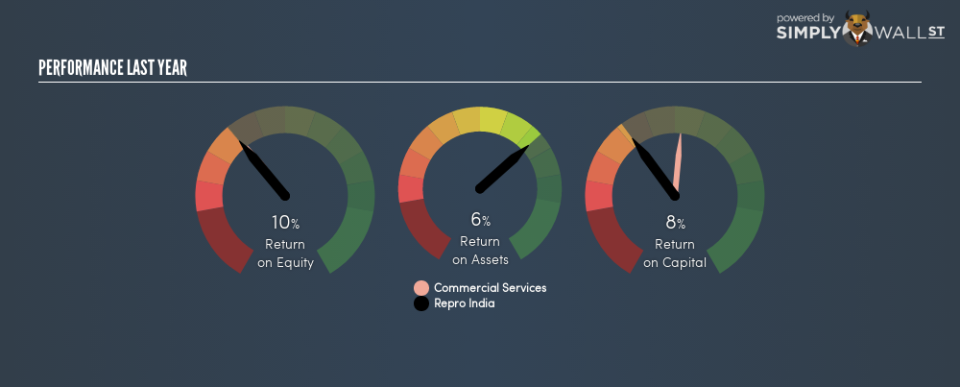Why We’re Not Impressed By Repro India Limited’s (NSE:REPRO) 7.6% ROCE

Today we’ll look at Repro India Limited (NSE:REPRO) and reflect on its potential as an investment. Specifically, we’ll consider its Return On Capital Employed (ROCE), since that will give us an insight into how efficiently the business can generate profits from the capital it requires.
First of all, we’ll work out how to calculate ROCE. Next, we’ll compare it to others in its industry. Then we’ll determine how its current liabilities are affecting its ROCE.
Return On Capital Employed (ROCE): What is it?
ROCE is a metric for evaluating how much pre-tax income (in percentage terms) a company earns on the capital invested in its business. All else being equal, a better business will have a higher ROCE. In brief, it is a useful tool, but it is not without drawbacks. Author Edwin Whiting says to be careful when comparing the ROCE of different businesses, since ‘No two businesses are exactly alike.’
So, How Do We Calculate ROCE?
Analysts use this formula to calculate return on capital employed:
Return on Capital Employed = Earnings Before Interest and Tax (EBIT) ÷ (Total Assets – Current Liabilities)
Or for Repro India:
0.076 = ₹192m ÷ (₹4.2b – ₹1.5b) (Based on the trailing twelve months to September 2018.)
Therefore, Repro India has an ROCE of 7.6%.
View our latest analysis for Repro India
Is Repro India’s ROCE Good?
ROCE can be useful when making comparisons, such as between similar companies. Using our data, Repro India’s ROCE appears to be significantly below the 14% average in the Commercial Services industry. This performance could be negative if sustained, as it suggests the business may underperform its industry. Independently of how Repro India compares to its industry, its ROCE in absolute terms is low; especially compared to the ~7.6% available in government bonds. Readers may wish to look for more rewarding investments.
Repro India’s current ROCE of 7.6% is lower than its ROCE in the past, which was 13%, 3 years ago. This makes us wonder if the business is facing new challenges.
When considering ROCE, bear in mind that it reflects the past and does not necessarily predict the future. Companies in cyclical industries can be difficult to understand using ROCE, as returns typically look high during boom times, and low during busts. ROCE is only a point-in-time measure. You can check if Repro India has cyclical profits by looking at this free graph of past earnings, revenue and cash flow.
What Are Current Liabilities, And How Do They Affect Repro India’s ROCE?
Liabilities, such as supplier bills and bank overdrafts, are referred to as current liabilities if they need to be paid within 12 months. The ROCE equation subtracts current liabilities from capital employed, so a company with a lot of current liabilities appears to have less capital employed, and a higher ROCE than otherwise. To counter this, investors can check if a company has high current liabilities relative to total assets.
Repro India has total liabilities of ₹1.5b and total assets of ₹4.2b. As a result, its current liabilities are equal to approximately 37% of its total assets. With a medium level of current liabilities boosting the ROCE a little, Repro India’s low ROCE is unappealing.
The Bottom Line On Repro India’s ROCE
So researching other companies may be a better use of your time. But note: Repro India may not be the best stock to buy. So take a peek at this free list of interesting companies with strong recent earnings growth (and a P/E ratio below 20).
If you are like me, then you will not want to miss this free list of growing companies that insiders are buying.
To help readers see past the short term volatility of the financial market, we aim to bring you a long-term focused research analysis purely driven by fundamental data. Note that our analysis does not factor in the latest price-sensitive company announcements.
The author is an independent contributor and at the time of publication had no position in the stocks mentioned. For errors that warrant correction please contact the editor at editorial-team@simplywallst.com.

 Yahoo Finance
Yahoo Finance 
